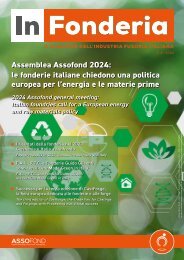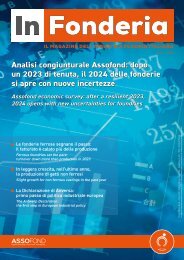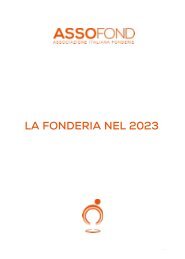In Fonderia 2 2024
Secondo numero del 2024 di In Fonderia
Secondo numero del 2024 di In Fonderia
Create successful ePaper yourself
Turn your PDF publications into a flip-book with our unique Google optimized e-Paper software.
IN PRIMO PIANO<br />
sibili riutilizzi esterni alternativi alla tradizionale<br />
attività di smaltimento.<br />
Le scelte operate, oltre a contribuire a risolvere<br />
i problemi legati agli aspetti ambientali dello<br />
smaltimento dei residui di produzione, si sono<br />
rivelate vantaggiose anche dal punto di vista<br />
della gestione economica, confermando le tesi<br />
che individuano negli investimenti ambientali<br />
opportunità e non costi per l’impresa.<br />
Emblematico della tendenza verso l’economia<br />
circolare nella gestione dei rifiuti è il caso<br />
delle terre esauste. Oltre alla diminuzione in<br />
assoluto dei quantitativi prodotti, passati dai<br />
circa 575 chilogrammi per tonnellata di getti<br />
prodotti del 2000 ai 324 del 2019 (con una<br />
riduzione superiore al 43%), è interessante osservare<br />
come già oggi gran parte delle terre<br />
esauste possa essere recuperata attraverso<br />
riutilizzi esterni in impieghi come materie prime<br />
in sostituzione di sabbie e terre da estrazione.<br />
Una tendenza che si colloca in pieno accordo,<br />
ancora una volta, con i principi dell’economia<br />
circolare, che intende valorizzare i residui di<br />
produzione (rifiuti o sottoprodotti) quali “materie<br />
prime seconde” utilizzabili all’interno di<br />
processi industriali quali i cementifici, le fornaci,<br />
o ancora per la fabbricazione di manufatti<br />
per l’edilizia e l’ingegneria civile.<br />
LE LINEE GUIDA DI REGIONE LOMBARDIA<br />
PER IL RIUTILIZZO DELLE SABBIE ESAUSTE<br />
Per incentivare ulteriormente questa tendenza,<br />
Assofond ha partecipato negli scorsi anni<br />
al Tavolo Tecnico “Scorie di fusione”, istituito da<br />
Regione Lombardia per fornire a tutti i soggetti<br />
coinvolti un quadro di riferimento tecnico-normativo<br />
chiaro e condiviso per la gestione<br />
circolare di alcuni dei principali residui delle<br />
attività siderurgiche e metallurgiche presenti<br />
sul territorio regionale.<br />
Il tavolo di lavoro ha portato, infine, all’approvazione<br />
da parte di Regione Lombardia delle<br />
“Linee guida regionali per la gestione delle<br />
terre di fonderia di metalli ferrosi” (D.G.R. n°<br />
XI/6071 del 07/03/2022) e, successivamente,<br />
a un documento analogo dedicato alle fonderie<br />
di metalli non ferrosi (D.G.R. n° XII/134 del<br />
17/04/2023).<br />
I due documenti costituiscono un importante<br />
punto di riferimento per la gestione delle<br />
terre esauste prodotte da tutte le tipologie<br />
di fonderie italiane che utilizzano la formatura<br />
in sabbia a perdere all’interno del loro ciclo<br />
panies in the foundry sector have been concentrating<br />
on residue management, aiming to<br />
decrease the amount of residue, incentivising<br />
reuse in foundry processes, and researching<br />
external reuse as an alternative to traditional<br />
disposal.<br />
The choices made, as well as helping to solve<br />
the environmental problems of disposing production<br />
residues, were found to be advantageous<br />
also from the viewpoint of economic<br />
management, confirming the view that environmental<br />
investments are opportunities and<br />
not costs for businesses.<br />
Spent sands is a prime example of the trend<br />
towards a circular economy in waste management.<br />
<strong>In</strong> addition to the absolute decrease in<br />
the amount produced, from around 575 kilograms<br />
per ton of castings produced in 2000<br />
to 324 Kg/ton in 2019 (with a reduction of over<br />
43%), it is interesting to observe that today<br />
most spent sands can be recovered through<br />
external reuse as a raw material in place of<br />
sand and minerals.<br />
This trend is in full agreement, once again, with<br />
the principles of the circular economy, which<br />
aims to exploit production residues (waste or<br />
by-products) as ‘secondary raw materials’<br />
that can be used in industrial processes like<br />
cement factories or kilns or to manufacture<br />
building and civil engineering products.<br />
LOMBARDY REGION GUIDELINES FOR<br />
REUSING SPENT SANDS<br />
To further incentivise this trend, Assofond has<br />
taken part in recent years in the Scorie di fusione<br />
[casting waste] technical committee set<br />
up by the Lombardy Region to provide all<br />
stakeholders with a clear, shared technical and<br />
regulatory framework for circular management<br />
of some of the main residual waste from<br />
steel and metallurgical activities in the region.<br />
The roundtable in the end led to the approval<br />
by the Lombardy Region of the “Regional<br />
guidelines for the management of ferrous<br />
foundry sands” (Regional Government Decree<br />
n° XI/6071 of 07/03/2022) and, subsequently,<br />
of a similar document dedicated to non ferrous<br />
foundries (Regional Government Decree<br />
n° XII/134 of 17/04/2023).<br />
The two documents represent an important<br />
reference point for managing spent sands<br />
produced by all types of Italian foundries that<br />
use disposable sand mouldings in their pro-<br />
<strong>In</strong> <strong>Fonderia</strong><br />
21














